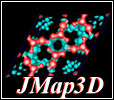
Iso-Surface Generator
© Steffen Weber 1999
|
JMap3D Iso-Surface Generator
|
| This program takes
volumetric data (particularly electron density
data) and polygonises them, in order to produce
up to five iso-surfaces. The result is written to a
VRML97 (VRML2.0) file, which can then be viewed with any
VRML viewer of your choice or with the included Java3D
VRML viewer (from the Java3D & VRML working group) .
This requires the installation of Java3D in addition to
the JDK1.2. JMap3D requires a Java Virtual Machine (JVM) installed on your computer wich can be downloaded for free in form of © Sun Microsystem's JDK 1.2 . For Windows users I strongly recommend to use the best VRML viewer available, called GLView3.6. This is a stand-alone viewer which offers many rendering options. I was disappointed when I used VRML plug-ins for web-browsers.
click at images to see them in their original size usage: Click check boxes of isosurface to be created. Choose the corresponding input files. Specify the isodensity values and transparencies for each isosurface. Choose scan step (1=full data set, 2= 1/8 of data set etc.). Specify filename for the VRML file. Click "start poligonizer". Then till the whole process is finished the background color of the log window will be green. After it turns gray again you can click "view VRML file" for viewing the isosurfaces with the provided VRML viewer (needs Java3D ) or use your own favorite VRML viewer. note: If you use several input files to create one VRML file, the unit cell dimensions should of course be the same in each of these files. Therefore the unit cell data are extracted always from the input file given for the isosurface no.1. If you use several input files, but one of them more than once then use it for successive isosurfaces. If JMap3D notices that two successive input files have the same name it only reads the data once, thus saving some time. Usually reading input data takes about 1.5 minutes for a 20Mb ASCII input file. |
*not available in the light version (contact me by email if you are interested in the full version)
The commas may be left out! Since the data files are very large, no sample file is included in the distribution. Density values have to be given for all grid points in the unit cell.
download Java Interpreterdownload Java3D for JDK1.2download
JMap3D-light
|